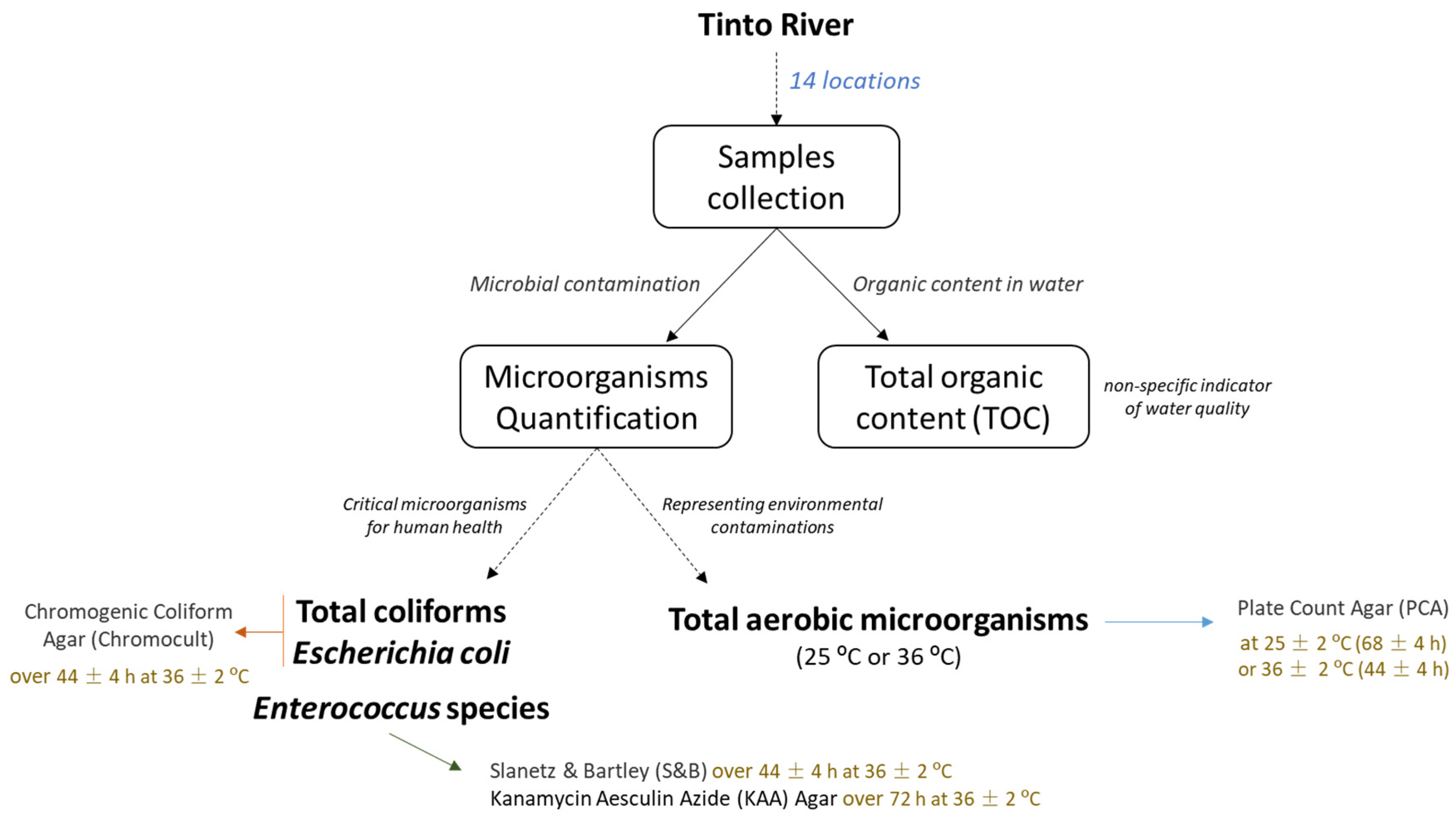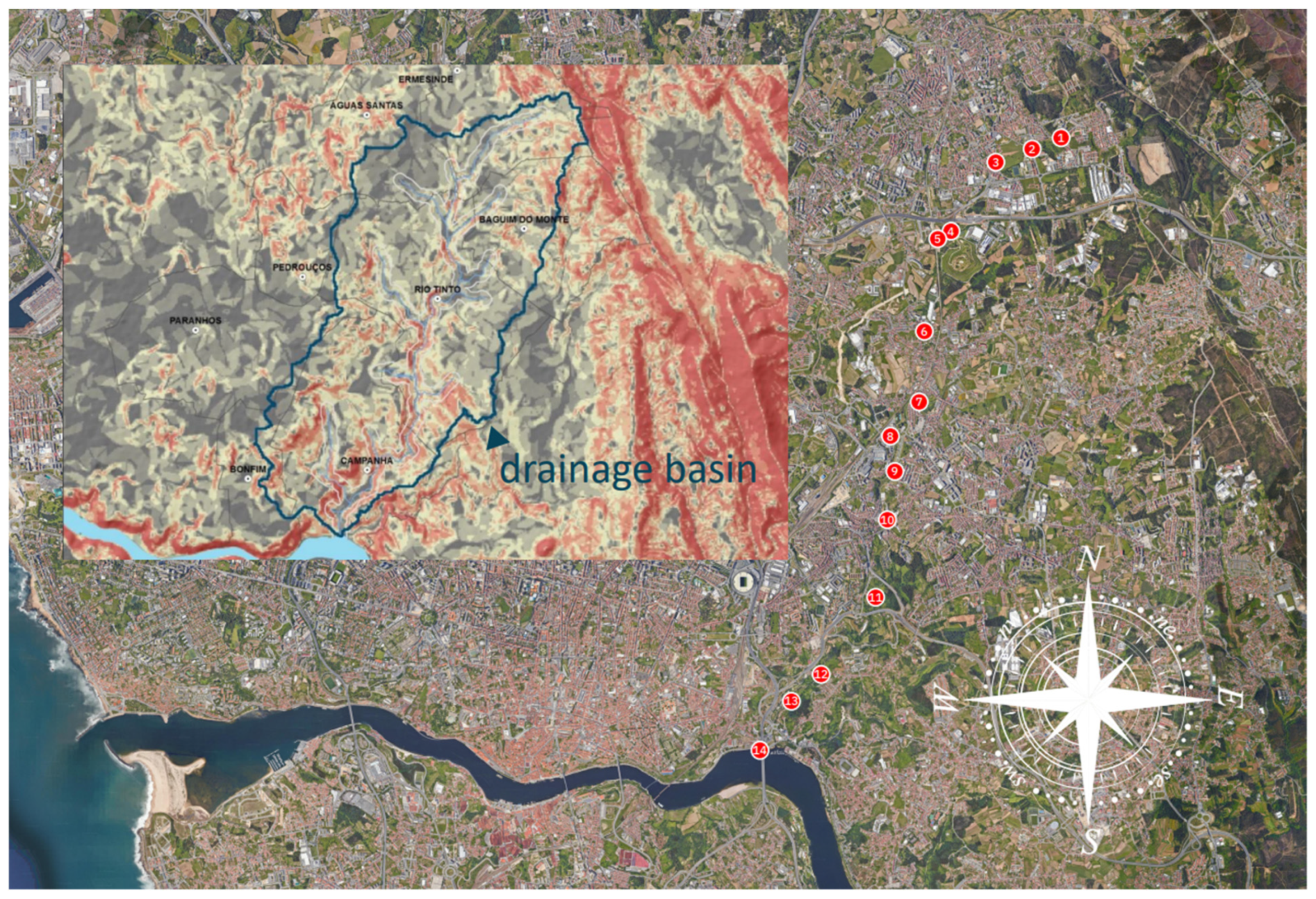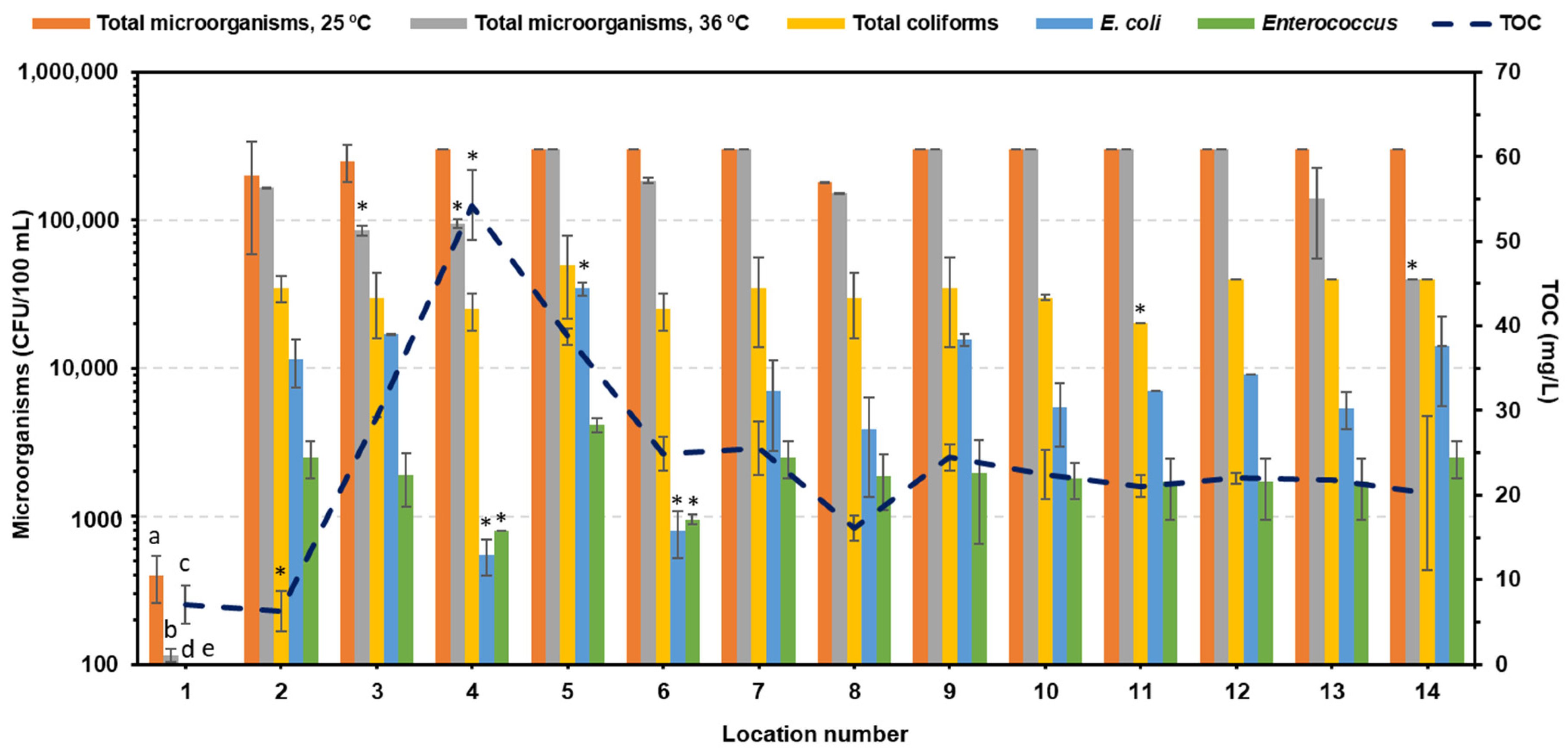Polluted Rivers—A Case Study in Porto, Portugal
Abstract
:1. Introduction
2. Materials and Methods
2.1. Study Area of Tinto River and Affluents
2.2. Total Organic Carbon (TOC) Determination
2.3. Reproducibility of the Results and Statistical Analysis
3. Results and Discussion
A Case Study of the Tinto River
4. Conclusions
Author Contributions
Funding
Institutional Review Board Statement
Informed Consent Statement
Data Availability Statement
Conflicts of Interest
Appendix A
Sampling Point Description and Methodology Flow Chart

References
- UNEP. Freshwater Strategy 2017–2021; The United Nations Environment Programme: Nairobi, Kenya, 2017. [Google Scholar]
- NIEHS. Water-Related Illnesses. Available online: https://www.niehs.nih.gov/research/programs/climatechange/health_impacts/waterborne_diseases/index.cfm (accessed on 25 April 2023).
- Akhtar, N.; Ishak, M.I.S.; Bhawani, S.A.; Umar, K. Various natural and anthropogenic factors responsible for water quality degradation: A review. Water 2021, 13, 2660. [Google Scholar] [CrossRef]
- Burri, N.M.; Weatherl, R.; Moeck, C.; Schirmer, M. A review of threats to groundwater quality in the anthropocene. Sci. Total Environ. 2019, 684, 136–154. [Google Scholar] [CrossRef] [PubMed]
- Ahmed, W.; Hamilton, K.; Toze, S.; Cook, S.; Page, D. A review on microbial contaminants in stormwater runoff and outfalls: Potential health risks and mitigation strategies. Sci. Total Environ. 2019, 692, 1304–1321. [Google Scholar] [CrossRef] [PubMed]
- Pharaoh, E.; Diamond, M.; Ormerod, S.J.; Rutt, G.; Vaughan, I.P. Evidence of biological recovery from gross pollution in English and Welsh rivers over three decades. Sci. Total Environ. 2023, 878, 163107. [Google Scholar] [CrossRef] [PubMed]
- Amoatey, P.; Baawain, M.S. Effects of pollution on freshwater aquatic organisms. Water Environ. Res. 2019, 91, 1272–1287. [Google Scholar] [CrossRef] [PubMed]
- Longe, E.O.; Omole, D.O. Analysis of pollution status of River Illo, Ota, Nigeria. Environmentalist 2008, 28, 451–457. [Google Scholar] [CrossRef]
- EPA. An Introduction to Water Quality Monitoring. Available online: https://archive.epa.gov/water/archive/web/html/monintr.html (accessed on 21 May 2023).
- OECD. Portugal’s National Recovery and Resilience Plan. 2022. Available online: https://commission.europa.eu/business-economy-euro/economic-recovery/recovery-and-resilience-facility/country-pages/portugals-recovery-and-resilience-plan_en (accessed on 10 April 2023).
- Lipor. Rio Tinto Recovery Project. 2015. Available online: https://www.lipor.pt/en/innovate/financed-projects/river-tinto-restoration-project/ (accessed on 20 May 2023).
- Rice, E.W.; Baird, R.B.; Eaton, A.D. Standard Methods for the Examination of Water and Wastewater, 23rd ed.; American Public Health Association: Washington, DC, USA; American Water Works Association: Denver, CO, USA; Water Environment Federation: Alexandria, VA, USA, 2017. [Google Scholar]
- Fernandes, D.T. A Paisagem Ribeirinha em Contexto Urbano—Um Modelo de Planeamento e Gobernação para a Bacia Hidrográfica do Rio Tinto. Ph.D. Thesis, Faculdade de Ciências da Universidade do Porto, Porto, Portugal, 2020. [Google Scholar]
- Climate Change Knowledge Portal. Available online: https://climateknowledgeportal.worldbank.org/country/portugal/climate-data-historical (accessed on 23 October 2023).
- Li, P.; Li, D.; Sun, X.; Chu, Z.; Xia, T.; Zheng, B. Application of ecological restoration technologies for the improvement of biodiversity and ecosystem in the river. Water 2022, 14, 1402. [Google Scholar] [CrossRef]
- Merck. Chromocult® Coliform Agar. 1995. Available online: https://www.merckmillipore.com/PT/en/product/Chromocult-Coliform-Agar,MM_NF-C164546?ReferrerURL=https%3A%2F%2Fwww.google.com%2F (accessed on 25 April 2023).
- Slanetz, L.W.; Bartley, C.H. Number of enterococci in water, sewage, and feces determined by the membrane filter technique with an improved medium. J. Bacteriol. 1957, 74, 591–595. [Google Scholar] [CrossRef]
- ThermoFisher. Dehydrated Culture Media—Kanamycin Aesculin Azide Agar Base; ThermoFisher Inc.: Waltham, MA, USA, 1998. [Google Scholar]
- Borja-Serrano, P.; Ochoa-Herrera, V.; Maurice, L.; Morales, G.; Quilumbaqui, C.; Tejera, E.; Machado, A. Determination of the microbial and chemical loads in rivers from the Quito capital province of Ecuador (Pichincha)—A preliminary analysis of microbial and chemical quality of the main rivers. Int. J. Environ. Res. Public Health 2020, 17, 5048. [Google Scholar] [CrossRef] [PubMed]
- Lenart-Boroń, A.; Wolanin, A.; Jelonkiewicz, E.; Żelazny, M. The effect of anthropogenic pressure shown by microbiological and chemical water quality indicators on the main rivers of Podhale, southern Poland. Environ. Sci. Pollut. Res. 2017, 24, 12938–12948. [Google Scholar] [CrossRef]
- Nhantumbo, C.; Cangi Vaz, N.; Rodrigues, M.; Manuel, C.; Rapulua, S.; Langa, J.; Nhantumbo, H.; Joaquim, D.; Dosse, M.; Sumbana, J.; et al. Assessment of Microbial Contamination in the Infulene River Basin, Mozambique. Water 2023, 15, 219. [Google Scholar] [CrossRef]
- Carvalho, C.D.F.; Stapelfeldt, F. Qualidade das águas do ribeirão Ubá-MG. Rev. Esc. Minas 2004, 57, 165–172. [Google Scholar] [CrossRef]
- Sandoval Villasana, A.M.; Pulido-Flores, G.; Monks, S.; Gordillo Martinez, A.J.; Villegas Villareal, E.C. Physicochemical, microbiological and toxicological evaluation of the environmental degradation of the Atoyac river, Mexico. Interciencia 2009, 37, 880–887. [Google Scholar]
- Decreto-Lei No. 236/98, Diário da República No. 176/1998, 1998. Available online: https://dre.pt/application/conteudo/430457 (accessed on 20 October 2022).
- Shetty, A.; Goyal, A. Total organic carbon analysis in water—A review of current methods. Mater. Today Proc. 2022, 65, 3881–3886. [Google Scholar] [CrossRef]
- Fekete, B.M. State of the World’s Water Resources. In Climate Vulnerability—Understanding and Addressing Threats to Essential Resources; Elias, S.A., Ed.; Elsevier Inc.: Amsterdam, The Netherlands, 2013; Volume 5, pp. 11–23. [Google Scholar] [CrossRef]




| Picking Point | Location Number | GPS Coordinates | Samples ID |
|---|---|---|---|
| “River Source” | 1 | 41.209853366678345 −8.537933108322587 | A1, D1 |
| “Prio Gas Station” | 2 | 41.20869074853031 −8.541528847316966 | C2, D2 |
| “Presas de Sá” | 3 | 41.20710548961442 −8.547250252840492 | C3, D3 |
| “Lipor Watermill” | 4 | 41.19958848134726 −8.55509042093266 | C4, D4 |
| “Granja Creek” | 5 | 41.199300462794334 −8.555304268076744 | C5, D5 |
| “Caneiro” | 6 | 41.187760506218154 −8.556703417085712 | C7, D7 |
| “Lourinha” | 7 | 41.18122056431281 −8.558955093715136 | D8, E8 |
| “Castanheira Creek” | 8 | 41.177438000751614 −8.563476039605014 | B10, E10 |
| “Vitória Watermill” | 9 | 41.173415420761636 −8.562057657537917 | B11, E11 |
| “Baixa da Ponte” | 10 | 41.16824084821879 −8.563342153608334 | B12, E12 |
| “Pego Negro” | 11 | 41.15999705881199 −8.564633560401608 | B13, E13 |
| “Azevedo de Campanhã” | 12 | 41.15195149933247 −8.572819639359995 | A14, E14 |
| “Freixo” | 13 | 41.14759752376573 −8.578804748463854 | B15, E15 |
| “Mouth of the Tinto River” | 14 | 41.14412454144438 −8.579096194097469 | B16, E16 |
Disclaimer/Publisher’s Note: The statements, opinions and data contained in all publications are solely those of the individual author(s) and contributor(s) and not of MDPI and/or the editor(s). MDPI and/or the editor(s) disclaim responsibility for any injury to people or property resulting from any ideas, methods, instructions or products referred to in the content. |
© 2024 by the authors. Licensee MDPI, Basel, Switzerland. This article is an open access article distributed under the terms and conditions of the Creative Commons Attribution (CC BY) license (https://creativecommons.org/licenses/by/4.0/).
Share and Cite
Lemos, P.; Silva, P.; Sousa, C.A.; Duarte, A.J. Polluted Rivers—A Case Study in Porto, Portugal. Ecologies 2024, 5, 188-197. https://doi.org/10.3390/ecologies5020012
Lemos P, Silva P, Sousa CA, Duarte AJ. Polluted Rivers—A Case Study in Porto, Portugal. Ecologies. 2024; 5(2):188-197. https://doi.org/10.3390/ecologies5020012
Chicago/Turabian StyleLemos, Patrícia, Paulo Silva, Cátia A. Sousa, and Abel J. Duarte. 2024. "Polluted Rivers—A Case Study in Porto, Portugal" Ecologies 5, no. 2: 188-197. https://doi.org/10.3390/ecologies5020012







